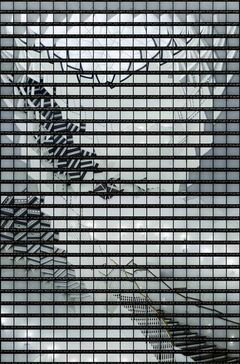Thomas Kellner: Dancing Walls at in focus Galerie Cologne
German Text below
Opening of the show and artist talk on Saturday, November 8, 2008 at 7 pm.
Show runs till December 23, 2008.
The in focus Galerie . Burkhard Arnold, Cologne presents a unique selection of the artist’s
large-scale color photographs from 2003 – 2006 of famous architectural monuments’ interiors. In contrast to many contemporary German photographers who studied under Bernd and Hilla Becher such as Andreas Gursky, Thomas Struth, or Candida Höfer, Thomas Kellner is not interested in objective, documentary photography. He focuses instead on the creative process, on the act of taking pictures and on the camera as the essential artistic tool. All works in the "Dancing Walls" series are artisticly arranged photomontages. Their language of fragmentation, reminiscent of cubistic and futuristic paintings, is permeated by a rhythmic musicality, which Kellner describes as a "vibration" or a "dancing glance".
The first exhibit from the work complex "Dancing Walls" is the programmatic piece "British Museum, 2005", which ingeniously transforms the architectural language of the "Great Court British Museum" project by the famous British architect Norman Foster into a kaleidoscopically arranged composition of dissected parts. Further highlights of the work complex are the series of radiantly luxuriant and golden interior views of the Genovese Pallazzi from 2005, which pars pro toto create an image of the city as a whole, and the single piece "Boston Athenaeum, 2006", which not only reflects the architectural language of that building’s exterior but also plays with a traditional metaphor in its motive of a staircase. A further central piece, created in 2006, is the photography "Mexico Munal", an additional inner view of a city’s landmark .
In "Dancing Walls", as well as in his continued earlier, open-ended series "Tango Metropolis", Thomas Kellner joins the ranks of photography history with his extraordinarily unique photographic method, which is based on his former experiments with the pinhole camera. Kellner records the architectural monuments with his camera in a way analogous to the natural process of seeing. The thus created series of single shots from a slightly slanted perspective are subsequently construed into a new picture.
With subversive irony Thomas Kellner’s architectural photographs do not appear as the postcardesque pictures of iconic monuments we carry in our minds, nor can they be seen as images documenting these monuments’ perfect form. His buildings do not appear consolidated, much rather deconstructed into multiple fragments and reconstructed to assume an entirely new form.
However, the ostensible interpretation of Kellner’s work as being cubistic-fragmentarian montages is too narrow. In fact, his art explores the history of the photography genre in a media-reflective way. Its essence lies within the fact that his large-scale color photographies are contact sheets composed of consecutively assembled filmstrips of a single shooting session. Specific pieces in "Dancing Walls" are made up of up to nine hundred shots, which translates into twenty-five rolls of film. This implies that the conceptual process begins far before the camera is actually implemented: the fragmentation of the image initially takes place within the artist’s mind. The end result amply reveals the photographic process, and even more so, it transcends the medium of photography to fundamentally argue in inter-media terms, in the dimension of the film:
"The vocabulary shared by the contact sheet, the zootrope and the motion picture is a simple assembly of images arranged one after the other in the order in which they were made, so that frozen moments in time are used to delineate space. We think of Edweard Muybridge, whose elaborate use of serial trip wires showed us the precise component movements of a horse’s streamlined gallop, or of the stilled beat of the hummingbird’s wing revealed by the stroboscopic experiments of Harold Edgerton. We are reminded that more and more of the newspaper photographs we consume are images sliced out of videotaped continuity. Kellner’s development of this working method shows an awareness of his medium’s past and present. It is self-reflexive, like so much contemporary art. It is even somewhat ironic in its choice of grand subject." (Alison Nordström, Curator of Photographs, George Eastman House International Museum of Photography and Film, Rochester, New York, in the exhibition catalog Thomas Kellner: Dancing Walls)
in focus Galerie . Burkhard Arnold . Bruesselerstrasse 83 . 50672 Koeln . Germany
Phone + Fax: ++ 49 221 1300341 .
Opening hours:
November 9 till November 22, daily 3 pm till 7 pm
November 23 till December 23 by appointment
German Pressrelease
Die in focus Galerie, Köln zeigt einen Querschnitt der zwischen 2003 und 2006 entstandenen großformatigen Farbfotografien von Innenräumen prominenter architektonischer Monumente. Bei den Arbeiten handelt es sich um höchst künstlerisch arrangierte Fotomontagen. Ihre vordergründig kubistisch anmutende Erscheinung ist durchdrungen von rhythmischer Musikalität, die Kellner selbst als „Vibration" oder „tanzender Blick" beschreibt. Diese, die gesamte Werkgruppe durchziehenden Schwingungen, fordern den Betrachter zum visuellen Tanzpartner auf. „Dancing Walls" sind aus neunhundert Einzelaufnahmen, ergo fünfundzwanzig Filmrollen, komponiert. Damit beginnt der konzeptuelle Prozess bereits im Vorfeld des Einsatzes der Kamera, die Bildzerlegung findet zuerst im Kopf des Künstlers statt. Das Ergebnis selbst stellt den fotografischen Prozess offen vor Augen, mehr noch es verlässt diesen, um in der Dimension des Filmischen zu argumentieren.
Mit subversiver Ironie stellen uns die Architekturfotografien von Thomas Kellner weder postkartentaugliche Erinnerungsbilder der Monumente vor Augen, noch sind sie dokumentarische Belege einer vollkommenen Gestalt. Statt verfestigt, erscheinen die Bauwerke in viele einzelne Fragmente dekonstruiert, die in ihrer Gesamtheit zu einer neuen Gestalt gefügt werden.
Entscheidend ist, dass es sich bei den großformatigen Farbfotografien um Kontaktabzüge handelt, die sich aus den zusammenmontierten, fortlaufenden Filmstreifen des Shootings aufbauen.
Thomas Kellners Arbeiten sind vorrangig in den vergangenen sieben Jahren in zahlreichen Ausstellungen in namhaften Galerien Europas und den USA, gezeigt worden. Für 2009 und 2010 gibt es bereits Ausstellungsvereinbarungen für Curitiba und Brasilia.
in focus Galerie
08.11 -23.12.2008
Bruesselerstrasse 83
D - 50672 Koeln
Öffnungszeiten:
9.- 22.11, täglich 15-19 Uhr
23.11 - 23.12. nach Vereinbarung
Eröffnung 8.11.2008 19 Uhr
www.infocusgalerie.de









